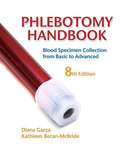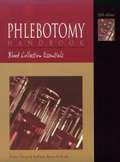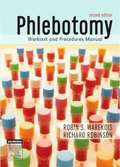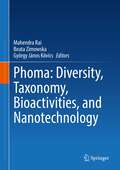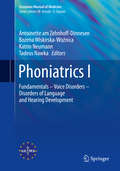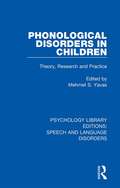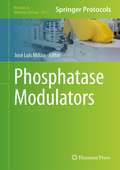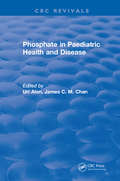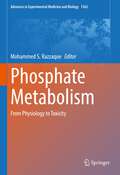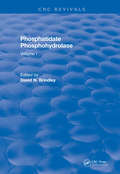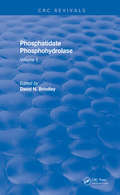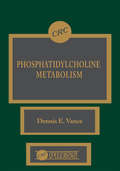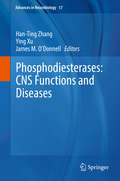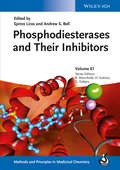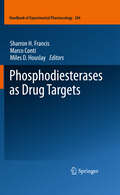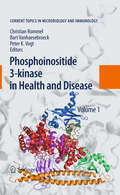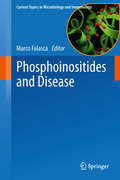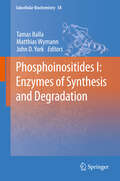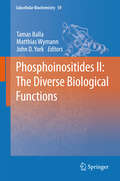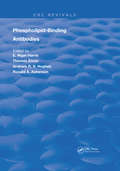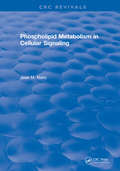- Table View
- List View
Phlebotomy Handbook: Blood Specimen Collection from Basic to Advanced (Eighth Edition)
by Diana Garza Kathleen Becan-McbrideThe 'Phlebotomy Handbook' is a comprehensive book covering blood and specimen collection. This eighth edition provides health care professionals with updated safety guidelines; condensed information about federal regulations; updates on equipment and supplies; new NCCLS standards and hazard prevention techniques; competencies important in the workplace; strategies for the certification process and securing a job; and extensive coverage on transcultural communication skills for all ages.
Phlebotomy Handbook: Blood Collection Essentials (Fifth Edition)
by Diana Garza Kathleen Becan-McbrideFor medical lab technology, medical assisting, respiratory therapy, radiological technology, and nursing courses. This leading text is the most accurate and current source of blood and specimen collection information for today's health care students and professionals. Designed to provide health care professionals with the clinical, technical, and communication skills and knowledge, it features sections devoted to safety; equipment and collection; special procedures and point of care testing; and quality and legal issues.
Phlebotomy Worktext and Procedure Manual (Second Edition)
by Richard Robinson Robin S. WarekoisThe book provides a complete introduction to the practice of phlebotomy in all its aspects.
Phoenix: The Life of Norman Bethune
by Roderick Stewart Sharon StewartRestless, dynamic, conflicted, a surgeon, an artist, and a writer, Norman Bethune was an extraordinary Canadian. Brilliant, yet erratic, Bethune's life was characterized by cycles of achievement and self-destruction and his adventurous spirit led him from the operating rooms of Montreal to the battlegrounds of Spain and China. In Phoenix: The Life of Norman Bethune Roderick and Sharon Stewart provide the intriguing details of Bethune's controversial career as a surgeon, his turbulent personal life, his passionate crusade to eradicate tuberculosis, and his pioneering commitment to the establishment of medicare in Canada. They also examine the reasoning that led Bethune to embrace Marxism and show the depth of his faith in the triumph of communism over fascism - a commitment that drove him to take risk after risk and ultimately led to his death from an infection caught while performing battlefield surgery in remote northern China. Based on extensive research in Canada, Spain, and China, and in-depth interviews with Bethune's family, friends, colleagues, and patients, Phoenix: The Life of Norman Bethune is the definitive Bethune biography for our time.
Phoenix
by Sharon Stewart Roderick StewartIn Phoenix: The Life of Norman Bethune Roderick and Sharon Stewart provide the intriguing details of Bethune's controversial career as a surgeon, his turbulent personal life, his passionate crusade to eradicate tuberculosis, and his pioneering commitment to the establishment of medicare in Canada. They also examine the reasoning that led Bethune to embrace Marxism and show the depth of his faith in the triumph of communism over fascism - a commitment that drove him to take risk after risk and ultimately led to his death from an infection caught while performing battlefield surgery in remote northern China. Based on extensive research in Canada, Spain, and China, and in-depth interviews with Bethune's family, friends, colleagues, and patients, Phoenix: The Life of Norman Bethune is the definitive Bethune biography for our time.
Phoma: Diversity, Taxonomy, Bioactivities, and Nanotechnology
by Mahendra Rai Beata Zimowska György János KövicsThe book covers the taxonomy, diversity, bioactivity, and nanotechnology involved in the study of the genus Phoma. It presents the most recent molecular taxonomic approach, secondary metabolites, different bioactivities, combating microbial threats, and its use in nanotechnology from a basic research to an applied perspective. Expert contributors provide the latest research and applications to present thorough coverage of this important genus in human and plant pathology and the disease management.
Phone Coaching in Dialectical Behavior Therapy (Guilford DBT® Practice Series)
by Alexander L. ChapmanThis is the first comprehensive guide to phone coaching in dialectical behavior therapy (DBT)--an integral part of treatment that many clinicians find challenging. What are the principles and goals of phone coaching? What limits should be set? How can a therapist manage suicide risk during a brief call? DBT expert Alexander Chapman addresses these and other critical practical questions in this accessible book. He provides guidelines for coaching core DBT distress tolerance and emotion regulation skills; coaching "dos and don'ts"; and tips for structuring each call's beginning, middle, and end. Featuring many concrete examples, strategies, and model dialogues, the book includes a key chapter on suicide crisis calls.
Phonetische und phonologische Störungen bei Kindern
by Martina Weinrich Heidrun ZehnerDieses Lehrbuch bietet im Bereich der Kindersprache tätigen Logopäden umfassendes Praxiswissen zur Diagnostik und Therapie kindlicher Aussprachestörungen. Die erfahrenen Autorinnen vermitteln kompakt die Grundlagen zu Phonetik und Phonologie sowie zum physiologischen Lauterwerb und erläutern die genaue Befunderhebung auch unter Aspekten von ICF. Sie stellen bewährte Therapiemethoden vor und zeigen das konkrete Vorgehen in der individuellen Therapiegestaltung. Profitieren Sie von zahlreichen praktischen Anregungen und Spielideen zur Lautbildung und –Verwendung. So gelingt die vielfältige und erfolgreiche Behandlung von Aussprachestörungen, die gleichzeitig die Sprachverarbeitungsfähigkeiten des Kindes miteinbezieht.
Phoniatrics I: Fundamentals – Voice Disorders – Disorders of Language and Hearing Development (European Manual of Medicine)
by Antoinette am Zehnhoff-Dinnesen Bożena Wiskirska-Woźnica Katrin Neumann Tadeus NawkaThis is the first of two volumes that draw on the specialized insights and extensive clinical experience of phoniatric experts in order to offer a basis for the development of concerted European training standards in phoniatrics, with the goal of guaranteeing a high quality of care for European patients in all age groups. The interdisciplinary character of phoniatrics is mirrored in the inclusion of valuable contributions from a range of other medical and non-medical disciplines. This volume focuses on voice disorders and disorders of language and hearing development. In each case a wide range of particular kinds of communication loss are considered. Basic aspects are fully addressed, and guidance provided on diagnostic methods, differential diagnosis, prevention, treatment/rehabilitation, and prognosis. An introductory section also discusses the fundamentals of phoniatrics. The reader will benefit from numerous color photos and tables as well as supplementary electronic material, including audio and video examples. This book is intended for residents and practitioners in phoniatrics and also for ENT physicians, medical students, logopedists, and speech and language pathologists and therapists.
Phonological Disorders in Children: Theory, Research and Practice (Psychology Library Editions: Speech and Language Disorders)
by Mehmet S. YavasOriginally published in 1991, the recent developments in the study of phonological disorders in children had led to a fruitful interaction between speech pathology and phonology. It is one aspect of the application of linguistic theory to the study of speech and language disorders which had opened up a new field, clinical linguistics. This book brings together the concerns of the linguist and the speech pathologist; the essays chosen share the quality of not discussing theory or therapy without addressing the implications one has for the other. By concentrating on recent work the editor hoped to stimulate further discussion in this important and fast growing area of research.
Phosphatase Modulators
by José Luis MillánDriving further the research on mammalian alkaline phosphatase structure and function, Phosphatase Modulators collects expert contributions into one "how to" manual for basic scientists interested in initiating a drug discovery effort. While this book contains the traditional method chapters and some typical reviews on the structure and known functions of phosphatases, other contributions are meant to discuss approaches and alternatives useful in making "go/no-go" decisions in high throughput screening (HTS) and lead optimization campaigns. Many chapters focus on tissue-nonspecific alkaline phosphatase (TNAP) as well as protein phosphatases. Written for the highly successful Methods in Molecular Biology series, chapters in this volume include the kind of detail and key implementation advice that promotes reproducible results. Step-by-step and practical, Phosphatase Modulators offers a path to understanding many of the facets and complexities associated with undertaking a drug discovery effort and will serve as a roadmap to initiating those efforts.
Phosphate in Paediatric Health and Disease
by U. AlonPhosphate in Pediatric Health and Disease provides a state-of-the-art overview of normal physiology, pathophysiology, genetics, clinical and therapeutic aspects of different types of phosphate homeostasis in early life. The book reviews the developmental physiology of phosphate metabolism from the fetus to the adolescent. It describes the pathophysiologic mechanisms associated with perturbations in phosphate homeostasis as well as discusses the different clinical conditions related to abnormal mineral metabolism, parathyroid hormone and vitamin D in infancy, childhood, and adolescence, and the modern diagnostic and therapeutic modalities. This book will benefit pediatricians, endocrinologists, neurologists, nutritionists, and researchers in the field of mineral metabolism.
Phosphate Metabolism: From Physiology to Toxicity (Advances in Experimental Medicine and Biology #1362)
by Mohammed S. RazzaqueThis contributed volume discusses the most important physiological aspects of phosphate metabolism, and how its pathological dysregulation can induce organ damage, which includes but is not limited to blood vessels, kidney, bone and tumor. The editor has selected a varied group of world renowned experts to provide a basic understanding of normal phosphate regulation, to then move on to explain the complex molecular mechanisms of abnormal phosphate regulation, also shedding some light on the downstream clinical consequences owing to phosphate toxicity. Each chapter clearly presents the biochemically important problems related to phosphate dysregulation with the necessary illustrations. Readers will be able to use the proposed book as a quick reference for updated information on phosphate metabolism, ranging from cellular system to physiology, from pathology to toxicity, also including the associated clinical consequences, without much prior acquaintance with the field.
Phosphatidate Phosphohydrolase: Volume I (CRC Press Revivals)
by David N. BrindleyEach of these chapters has a general section that describes the special needs for glycerolipid synthesis and the physiological context in which the regulation of phosphatidate phosphohydrolase activity can be understood.
Phosphatidate Phosphohydrolase: Volume II (CRC Press Revivals)
by David N. BrindleyEach of these chapters has a general section that describes the special needs for glycerolipid synthesis and the physiological context in which the regulation of phosphatidate phosphohydrolase activity can be understood.
Phosphatidylcholine Metabolism
by Dennis E. VanceThis book is the first to be published as a single source reference on phosphatidylcholine metabolism. It provides a cogent and timely summary of research in this topic.Beginning with a chapter by Eugene Kennedy providing an historical perspective; the book proceeds to describe the latest developments in enzymes involved in phosphatidylcholine biosynthesis. Biological chemists, students, and investigators in the field of lipid metabolism will find this book of great benefit in their research.
Phosphodiesterases: CNS Functions and Diseases
by Han-Ting Zhang Ying Xu James M. O’donnellPDEs are a family of enzymes that catalyze the hydrolysis of intracellular cyclic nucleotides. They are implicated in a number of disorders and dysfunctions and PDE inhibitors have already proven to be effective therapies for erectile dysfunction, COPD, and psoriatic arthritis. This family of enzymes also plays a role in diseases and disorders of the CNS such as depression, anxiety, schizophrenia, and Alzheimer's Disease. Unfortunately no effective PDE inhibitors have been developed for the treatment of these diseases. The proposed book will be a comprehensive overview of the current state of basic and translational research on PDE inhibitors written by internationally recognized experts. Authors will also discuss potential PDE subtypes and splice variants in the hopes that this will spur more creative approaches to PDE targeting drugs.
Phosphodiesterases and Their Inhibitors, Volume 61
by Andrew S. Bell Hugo Kubinyi Spiros Liras Raimund Mannhold Gerd FolkersWritten by the pioneers of Viagra, the first blockbuster PDE inhibitor drug. Beginning with a review of the first wave of phosphodiesterase (PDE) inhibitors, this book focuses on new and emerging PDE targets and their inhibitors. Drug development options for all major human PDE families are discussed and cover diverse therapeutic fields, such as neurological/psychiatric, cardiovascular/metabolic, pain, and allergy/respiratory diseases. Finally, emerging chemotherapeutic applications of PDE inhibitors against malaria and other tropical diseases are discussed.
Phosphodiesterases as Drug Targets
by Miles D. Houslay Sharron H. Francis Marco ContiCyclic nucleotide phosphodiesterases (PDEs) are promising targets for pharmacological intervention. Multiple PDE genes, isoform diversity, selective expression and compartmentation of the isoforms, and an array of conformations of PDE proteins are properties that challenge development of drugs that selectively target this class of enzymes. Novel characteristics of PDEs are viewed as unique opportunities to increase specificity and selectivity when designing novel compounds for certain therapeutic indications. This chapter provides a summary of the major concepts related to the design and use of PDE inhibitors.
Phosphoinositide 3-kinase in Health and Disease
by Christian Rommel Bart Vanhaesebroeck Peter K. VogtPI3K has become a very intense area of research, with over 2000 publications on PI3K in PubMed for 2009 alone. The expectations for a therapeutic impact of intervention with PI3K activity are high, and progress in the clinical arena is being monitored by many. However, targeted therapies almost invariably encounter roadblocks, often exposing unresolved questions in the basic understanding of the target
Phosphoinositides and Disease
by Marco FalascaPhosphoinositides (PIs) are minor components of cellular membranes that play critical regulatory roles in several intracellular functions. This book describes the main enzymes regulating the turnover of each of the seven PIs in mammalian cells, some of their intracellular functions and some evidence of their involvement in human diseases. Due to the complex inter-relation between the distinct PIs and the plethora of functions that they can regulate inside a cell, this book is not meant to be a comprehensive coverage of all aspects of PIs signalling but rather an overview on the current state of the field and where it could go from here. Phosphoinositide and inositol phosphates interact with and modulate the recruitment and activation of key regulatory proteins and in doing so control diverse functions including cell growth and proliferation, apoptosis, cytoskeletal dynamics, insulin action, vesicle trafficking and nuclear function. Initially, inositide signaling was limited to the PLC pathway; however, it is now clear that all the seven phosphoinositides and more than 30 different inositol phosphates likely have specific signaling functions. Moreover there is a growing list of proteins that are regulated by inositol signaling. This has raised the question as to how inositol signaling can control diverse processes and yet maintain signaling specificity. Controlling the levels of inositol signaling molecules and their subcellular compartmentalisation is likely to be critical. This meeting will bring together scientists from different backgrounds to discuss how understanding inositol signaling may be used to target complex human diseases that manifest themselves when inositol signaling is deregulated.
Phosphoinositides I: Enzymes of Synthesis and Degradation
by Matthias Wymann John D. York Tamas BallaPhosphoinositides play a major role in cellular signaling and membrane organization. During the last three decades we have learned that enzymes turning over phosphoinositides control vital physiological processes and are involved in the initiation and progression of cancer, inflammation, neurodegenerative, cardiovascular, metabolic disease and more. In two volumes, this book elucidates the crucial mechanisms that control the dynamics of phosphoinositide conversion. Starting out from phosphatidylinositol, a chain of lipid kinases collaborates to generate the oncogenic lipid phosphatidylinositol(3,4,5)-trisphosphate. For every phosphate group added, there are specific lipid kinases - and phosphatases to remove it. Additionally, phospholipases can cleave off the inositol head group and generate poly-phosphoinositols, which act as soluble signals in the cytosol. Volume I untangles the web of these enzymes and their products, and relates them to function in health and disease. Phosphoinositide 3-kinases and 3-phosphatases have received a special focus in volume I, and recent therapeutic developments in human disease are presented along with a historical perspective illustrating the impressive progress in the field.
Phosphoinositides II: The Diverse Biological Functions
by Matthias Wymann John D. York Tamas BallaPhosphoinositides play a major role in cellular signaling and membrane organization. During the last three decades we have learned that enzymes turning over phosphoinositides control vital physiological processes and are involved in the initiation and progression of cancer, inflammation, neurodegenerative, cardiovascular, metabolic disease and more. In two volumes, this book elucidates the crucial mechanisms that control the dynamics of phosphoinositide conversion. Starting out from phosphatidylinositol, a chain of lipid kinases collaborates to generate the oncogenic lipid phosphatidylinositol(3,4,5)-trisphosphate. For every phosphate group added, there are specific lipid kinases - and phosphatases to remove it. Additionally, phospholipases can cleave off the inositol head group and generate poly-phosphoinositols, which act as soluble signals in the cytosol. Volume II extends into the role of phosphoinositides in membrane organization and vesicular traffic. Endocytosis and exocytosis are modulated by phosphoinositides, which determine the fate and activity of integral membrane proteins. Phosphatidylinositol(4,5)-bisphosphate is a prominent flag in the plasma membrane, while phosphatidylinositol-3-phosphate decorates early endosomes. The Golgi apparatus is rich in phosphatidylinositol-4-phosphate, stressed cells increase phosphatidylinositol(3,5)-bisphosphate, and the nucleus has a phosphoinositide metabolism of its own. Phosphoinositide-dependent signaling cascades and the spatial organization of distinct phosphoinositide species are required in organelle function, fission and fusion, membrane channel regulation, cytoskeletal rearrangements, adhesion processes, and thus orchestrate complex cellular responses including growth, proliferation, differentiation, cell motility, and cell polarization.
Phospholipid-Binding Antibodies (Routledge Revivals)
by E. Nigel Harris Thomas Exner Graham R. Hughes Ronald A. AshersonFirst published in 1991. Historically, phospholipid binding antibodies were important in the study of syphilis. During the 1980s there was a resurgence of new interest in these antibodies due to reported associations with recurrent thrombosis, fetal loss, and other clinical disorders. Because of the variety of reported clinical associations and their occurrence in systemic autoimmune disorders, these antibodies have become important in many medical fields, such as clinical immunology, rheumatology, hematology, and obstetrics and gynecology. Phospholipid-Binding Antibodies provides in-depth reviews by specialists in these clinical areas and covers topics including the biochemistry of phospholipids, their role in coagulation, phospholipid immunology, and lupus anticoagulant and antiphospholipid antibodies by solid phase immunoassays. Other topics include thrombosis and fetal loss, as well as the role of phospholipid binding antibodies in these disorders. Antiphospholipid Syndrome and its reported clinical associations is also discussed.
Phospholipid Metabolism in Cellular Signaling
by Jose M. MatoPhospholipids are no longer considered exclusively as the building blocks of biomembranes, but are now regarded to be exceptionally important to cellular signalling.Another conclusion resulting from studies over the past several years is that no single general scheme for the role of phospholipids during cell activation can be drawn as representative of all cells. This book presents a comprehensive view of the recent advances made in certain major research areas within the field of phospholipid metabolism in cellular signalling. Topics discussed within this volume include lipid composition of cellular membranes and their organization in biological systems, the dynamic aspects of phospholipid metabolism and its regulation by extracellular stimuli, and the role of newly discovered glycosyl-phosphatidylinositols in insulin action . The book also discusses two biologically active phospholipids: the sphingolipids, and ether-linked glycerophospholipids (the platelet activating factor). Phospholipid Metabolism in Cellular Signaling is an important research reference that should be considered required reading by all scientists and graduate students working on cell activation (e.g., growth factors, hormones, and oncogenes).
